SNOSC16D March 2000 – January 2015 LM124-N , LM224-N , LM2902-N , LM324-N
PRODUCTION DATA.
- 1 Features
- 2 Applications
- 3 Description
- 4 Revision History
- 5 Pin Configuration and Functions
- 6 Specifications
- 7 Detailed Description
- 8 Application and Implementation
- 9 Power Supply Recommendations
- 10Layout
- 11Device and Documentation Support
- 12Mechanical, Packaging, and Orderable Information
封装选项
机械数据 (封装 | 引脚)
散热焊盘机械数据 (封装 | 引脚)
- D|14
订购信息
6 Specifications
6.1 Absolute Maximum Ratings
See (5)(3).| LM124-N/LM224-N/LM324-N LM124A/LM224A/LM324A |
LM2902-N | ||||||
|---|---|---|---|---|---|---|---|
| MIN | MAX | MIN | MAX | UNIT | |||
| Supply Voltage, V+ | 32 | 26 | V | ||||
| Differential Input Voltage | 32 | 26 | V | ||||
| Input Voltage | −0.3 | 32 | −0.3 | 26 | V | ||
| Input Current (VIN < −0.3 V)(4) | 50 | 50 | mA | ||||
| Power Dissipation(1) | PDIP | 1130 | 1130 | mW | |||
| CDIP | 1260 | 1260 | mW | ||||
| SOIC Package | 800 | 800 | mW | ||||
| Output Short-Circuit to GND (One Amplifier)(2) | V+ ≤ 15 V and TA = 25°C | Continuous | Continuous | ||||
| Lead Temperature (Soldering, 10 seconds) | 260 | 260 | °C | ||||
| Soldering Information | Dual-In-Line Package | Soldering (10 seconds) | 260 | 260 | °C | ||
| Small Outline Package | Vapor Phase (60 seconds) | 215 | 215 | °C | |||
| Infrared (15 seconds) | 220 | 220 | °C | ||||
| Storage temperature, Tstg | –65 | 150 | –65 | 150 | °C | ||
(1) For operating at high temperatures, the LM324-N/LM324A/LM2902-N must be derated based on a 125°C maximum junction temperature and a thermal resistance of 88°C/W which applies for the device soldered in a printed circuit board, operating in a still air ambient. The LM224-N/LM224A and LM124-N/LM124A can be derated based on a 150°C maximum junction temperature. The dissipation is the total of all four amplifiers—use external resistors, where possible, to allow the amplifier to saturate of to reduce the power which is dissipated in the integrated circuit.
(2) Short circuits from the output to V+ can cause excessive heating and eventual destruction. When considering short circuits to ground, the maximum output current is approximately 40 mA independent of the magnitude of V+. At values of supply voltage in excess of 15 V, continuous short-circuits can exceed the power dissipation ratings and cause eventual destruction. Destructive dissipation can result from simultaneous shorts on all amplifiers.
(3) If Military/Aerospace specified devices are required, please contact the Texas Instruments Sales Office/ Distributors for availability and specifications.
(4) This input current will only exist when the voltage at any of the input leads is driven negative. It is due to the collector-base junction of the input PNP transistors becoming forward biased and thereby acting as input diode clamps. In addition to this diode action, there is also lateral NPN parasitic transistor action on the IC chip. This transistor action can cause the output voltages of the op amps to go to the V+voltage level (or to ground for a large overdrive) for the time duration that an input is driven negative. This is not destructive and normal output states will re-establish when the input voltage, which was negative, again returns to a value greater than −0.3 V (at 25°C).
(5) Refer to RETS124AX for LM124A military specifications and refer to RETS124X for LM124-N military specifications.
6.2 ESD Ratings
| VALUE | UNIT | |||
|---|---|---|---|---|
| V(ESD) | Electrostatic discharge | Human-body model (HBM), per ANSI/ESDA/JEDEC JS-001(1) | ±250 | V |
(1) JEDEC document JEP155 states that 500-V HBM allows safe manufacturing with a standard ESD control process.
6.3 Recommended Operating Conditions
over operating free-air temperature range (unless otherwise noted)| MIN | MAX | UNIT | ||
|---|---|---|---|---|
| Supply Voltage (V+ - V-): LM124-N/LM124A/LM224-N/LM224A/LM324-N/LM324A | 3 | 32 | V | |
| Supply Voltage (V+ - V-): LM2902-N | 3 | 26 | V | |
| Operating Input Voltage on Input pins | 0 | V+ | V | |
| Operating junction temperature, TJ: LM124-N/LM124A | -55 | 125 | °C | |
| Operating junction temperature, TJ: L2902-N | -40 | 85 | °C | |
| Operating junction temperature, TJ: LM224-N/LM224A | -25 | 85 | °C | |
| Operating junction temperature, TJ: LM324-N/LM324A | 0 | 70 | °C | |
6.4 Thermal Information
| THERMAL METRIC(1) | LM124-N / LM224-N | LM324-N / LM2902-N | UNIT | |
|---|---|---|---|---|
| J/CDIP | D/SOIC | |||
| 14 PINS | 14 PINS | |||
| RθJA | Junction-to-ambient thermal resistance | 88 | 88 | °C/W |
(1) For more information about traditional and new thermal metrics, see the IC Package Thermal Metrics application report, SPRA953.
6.5 Electrical Characteristics: LM124A/224A/324A
V+ = 5.0 V, (1), unless otherwise stated| PARAMETER | TEST CONDITIONS | LM124A | LM224A | LM324A | UNIT | ||||||||
|---|---|---|---|---|---|---|---|---|---|---|---|---|---|
| MIN | TYP | MAX | MIN | TYP | MAX | MIN | TYP | MAX | |||||
| Input Offset Voltage | TA = 25°C(2) | 1 | 2 | 1 | 3 | 2 | 3 | mV | |||||
| Input Bias Current(3) | IIN(+) or IIN(−), VCM = 0 V, TA = 25°C |
20 | 50 | 40 | 80 | 45 | 100 | nA | |||||
| Input Offset Current | IIN(+) or IIN(−), VCM = 0 V, TA = 25°C |
2 | 10 | 2 | 15 | 5 | 30 | nA | |||||
| Input Common-Mode Voltage Range(4) |
V+ = 30 V, (LM2902-N, V+ = 26 V), TA = 25°C |
0 | V+−1.5 | 0 | V+−1.5 | 0 | V+−1.5 | V | |||||
| Supply Current | Over Full Temperature Range, RL = ∞ On All Op Amps V+ = 30 V (LM2902-N V+ = 26 V) |
1.5 | 3 | 1.5 | 3 | 1.5 | 3 | mA | |||||
| V+ = 5 V | 0.7 | 1.2 | 0.7 | 1.2 | 0.7 | 1.2 | |||||||
| Large Signal Voltage Gain |
V+ = 15 V, RL≥ 2 kΩ, (VO = 1 V to 11 V), TA = 25°C |
50 | 100 | 50 | 100 | 25 | 100 | V/mV | |||||
| Common-Mode Rejection Ratio |
DC, VCM = 0 V to V+ − 1.5 V, TA = 25°C |
70 | 85 | 70 | 85 | 65 | 85 | dB | |||||
| Power Supply Rejection Ratio |
V+ = 5 V to 30 V, (LM2902-N, V+ = 5V to 26 V), TA = 25°C |
65 | 100 | 65 | 100 | 65 | 100 | dB | |||||
| Amplifier-to-Amplifier Coupling(5) |
f = 1 kHz to 20 kHz, TA = 25°C, (Input Referred) |
−120 | −120 | −120 | dB | ||||||||
| Output Current | Source | VIN+ = 1 V, VIN− = 0 V, V+ = 15 V, VO = 2 V, TA = 25°C |
20 | 40 | 20 | 40 | 20 | 40 | mA | ||||
| Sink | VIN− = 1 V, VIN+ = 0 V, V+ = 15 V, VO = 2 V, TA = 25°C |
10 | 20 | 10 | 20 | 10 | 20 | μA | |||||
| VIN− = 1 V, VIN+ = 0 V, V+ = 15 V, VO = 200 mV, TA = 25°C |
12 | 50 | 12 | 50 | 12 | 50 | |||||||
| Short Circuit to Ground | V+ = 15 V, TA = 25°C(2) |
40 | 60 | 40 | 60 | 40 | 60 | mA | |||||
| Input Offset Voltage | See(2) | 4 | 4 | 5 | mV | ||||||||
| VOS Drift | RS = 0 Ω | 7 | 20 | 7 | 20 | 7 | 30 | μV/°C | |||||
| Input Offset Current | IIN(+) − IIN(−), VCM = 0 V | 30 | 30 | 75 | nA | ||||||||
| IOS Drift | RS = 0 Ω | 10 | 200 | 10 | 200 | 10 | 300 | pA/°C | |||||
| Input Bias Current | IIN(+) or IIN(−) | 40 | 100 | 40 | 100 | 40 | 200 | nA | |||||
| Input Common-Mode Voltage Range(4) |
V+ = 30 V, (LM2902-N, V+ = 26 V) |
0 | V+−2 | 0 | V+−2 | 0 | V+−2 | V | |||||
| Large Signal Voltage Gain |
V+ = 15 V (VOSwing = 1 V to 11 V), RL ≥ 2 kΩ |
25 | 25 | 15 | V/mV | ||||||||
| Output Voltage Swing | VOH | V+ = 30 V (LM2902-N, V+ = 26 V) |
RL = 2 kΩ | 26 | 26 | 26 | V | ||||||
| RL = 10 kΩ | 27 | 28 | 27 | 28 | 27 | 28 | |||||||
| VOL | V+ = 5 V, RL = 10 kΩ | 5 | 20 | 5 | 20 | 5 | 20 | mV | |||||
| Output Current | Source | VO = 2 V | VIN+ = +1V, VIN− = 0V, V+ = 15V |
10 | 20 | 10 | 20 | 10 | 20 | mA | |||
| Sink | VIN− = +1V, VIN+ = 0V, V+ = 15V |
10 | 15 | 5 | 8 | 5 | 8 | ||||||
(1) These specifications are limited to −55°C ≤ TA ≤ +125°C for the LM124-N/LM124A. With the LM224-N/LM224A, all temperature specifications are limited to −25°C ≤ TA ≤ +85°C, the LM324-N/LM324A temperature specifications are limited to 0°C ≤ TA ≤ +70°C, and the LM2902-N specifications are limited to −40°C ≤ TA ≤ +85°C.
(2) VO ≃ 1.4V, RS = 0 Ω with V+ from 5 V to 30 V; and over the full input common-mode range (0 V to V+ − 1.5 V) for LM2902-N, V+ from 5 V to 26 V.
(3) The direction of the input current is out of the IC due to the PNP input stage. This current is essentially constant, independent of the state of the output so no loading change exists on the input lines.
(4) The input common-mode voltage of either input signal voltage should not be allowed to go negative by more than 0.3 V (at 25°C). The upper end of the common-mode voltage range is V+ − 1.5 V (at 25°C), but either or both inputs can go to 32 V without damage (26 V for LM2902-N), independent of the magnitude of V+.
(5) Due to proximity of external components, insure that coupling is not originating via stray capacitance between these external parts. This typically can be detected as this type of capacitance increases at higher frequencies.
6.6 Electrical Characteristics: LM124-N/224-N/324-N/2902-N
V+ = +5.0V, (1), unless otherwise stated| PARAMETER | TEST CONDITIONS | LM124-N / LM224-N | LM324-N | LM2902-N | UNIT | ||||||||
|---|---|---|---|---|---|---|---|---|---|---|---|---|---|
| MIN | TYP | MAX | MIN | TYP | MAX | MIN | TYP | MAX | |||||
| Input Offset Voltage | TA = 25°C(2) | 2 | 5 | 2 | 7 | 2 | 7 | mV | |||||
| Input Bias Current(3) | IIN(+) or IIN(−), VCM = 0 V, TA = 25°C | 45 | 150 | 45 | 250 | 45 | 250 | nA | |||||
| Input Offset Current | IIN(+) or IIN(−), VCM = 0 V, TA = 25°C | 3 | 30 | 5 | 50 | 5 | 50 | nA | |||||
| Input Common-Mode Voltage Range(4) | V+ = 30 V, (LM2902-N, V+ = 26V), TA = 25°C |
0 | V+−1.5 | 0 | V+−1.5 | 0 | V+−1.5 | V | |||||
| Supply Current | Over Full Temperature Range RL = ∞ On All Op Amps, V+ = 30 V (LM2902-N V+ = 26 V) |
1.5 | 3 | 1.5 | 3 | 1.5 | 3 | mA | |||||
| V+ = 5 V | 0.7 | 1.2 | 0.7 | 1.2 | 0.7 | 1.2 | |||||||
| Large Signal Voltage Gain | V+ = 15V, RL≥ 2 kΩ, (VO = 1 V to 11 V), TA = 25°C |
50 | 100 | 25 | 100 | 25 | 100 | V/mV | |||||
| Common-Mode Rejection Ratio | DC, VCM = 0 V to V+ − 1.5 V, TA = 25°C | 70 | 85 | 65 | 85 | 50 | 70 | dB | |||||
| Power Supply Rejection Ratio | V+ = 5 V to 30 V (LM2902-N, V+ = 5 V to 26 V), TA = 25°C |
65 | 100 | 65 | 100 | 50 | 100 | dB | |||||
| Amplifier-to-Amplifier Coupling(5) |
f = 1 kHz to 20 kHz, TA = 25°C (Input Referred) |
−120 | −120 | −120 | dB | ||||||||
| Output Current | Source | VIN+ = 1 V, VIN− = 0 V, V+ = 15 V, VO = 2 V, TA = 25°C |
20 | 40 | 20 | 40 | 20 | 40 | mA | ||||
| Sink | VIN− = 1 V, VIN+ = 0 V, V+ = 15 V, VO = 2 V, TA = 25°C |
10 | 20 | 10 | 20 | 10 | 20 | mA | |||||
| VIN− = 1 V, VIN+ = 0 V, V+ = 15 V, VO = 200 mV, TA = 25°C |
12 | 50 | 12 | 50 | 12 | 50 | µA | ||||||
| Short Circuit to Ground | V+ = 15 V, TA = 25°C(2) | 40 | 60 | 40 | 60 | 40 | 60 | mA | |||||
| Input Offset Voltage | See (2) | 7 | 9 | 10 | mV | ||||||||
| VOS Drift | RS = 0 Ω | 7 | 7 | 7 | µV/°C | ||||||||
| Input Offset Current | IIN(+) − IIN(−), VCM = 0 V | 100 | 150 | 45 | 200 | nA | |||||||
| IOS Drift | RS = 0 Ω | 10 | 10 | 10 | pA/°C | ||||||||
| Input Bias Current | IIN(+) or IIN(−) | 40 | 300 | 40 | 500 | 40 | 500 | nA | |||||
| Input Common-Mode Voltage Range(4) | V+ = 30 V, (LM2902-N, V+ = 26 V) | 0 | V+−2 | 0 | V+−2 | 0 | V+−2 | V | |||||
| Large Signal Voltage Gain | V+ = 15 V (VOSwing = 1V to 11V), RL ≥ 2 kΩ |
25 | 15 | 15 | V/mV | ||||||||
| Output Voltage Swing | VOH | V+ = 30 V (LM2902-N, V+ = 26 V) |
RL = 2 kΩ | 26 | 26 | 22 | V | ||||||
| RL = 10 kΩ | 27 | 28 | 27 | 28 | 23 | 24 | |||||||
| VOL | V+ = 5 V, RL = 10 kΩ | 5 | 20 | 5 | 20 | 5 | 100 | mV | |||||
| Output Current | Source | VO = 2 V | VIN+ = 1 V, VIN− = 0 V, V+ = 15 V |
10 | 20 | 10 | 20 | 10 | 20 | mA | |||
| Sink | VIN− = 1 V, VIN+ = 0 V, V+ = 15 V |
5 | 8 | 5 | 8 | 5 | 8 | mA | |||||
6.7 Typical Characteristics
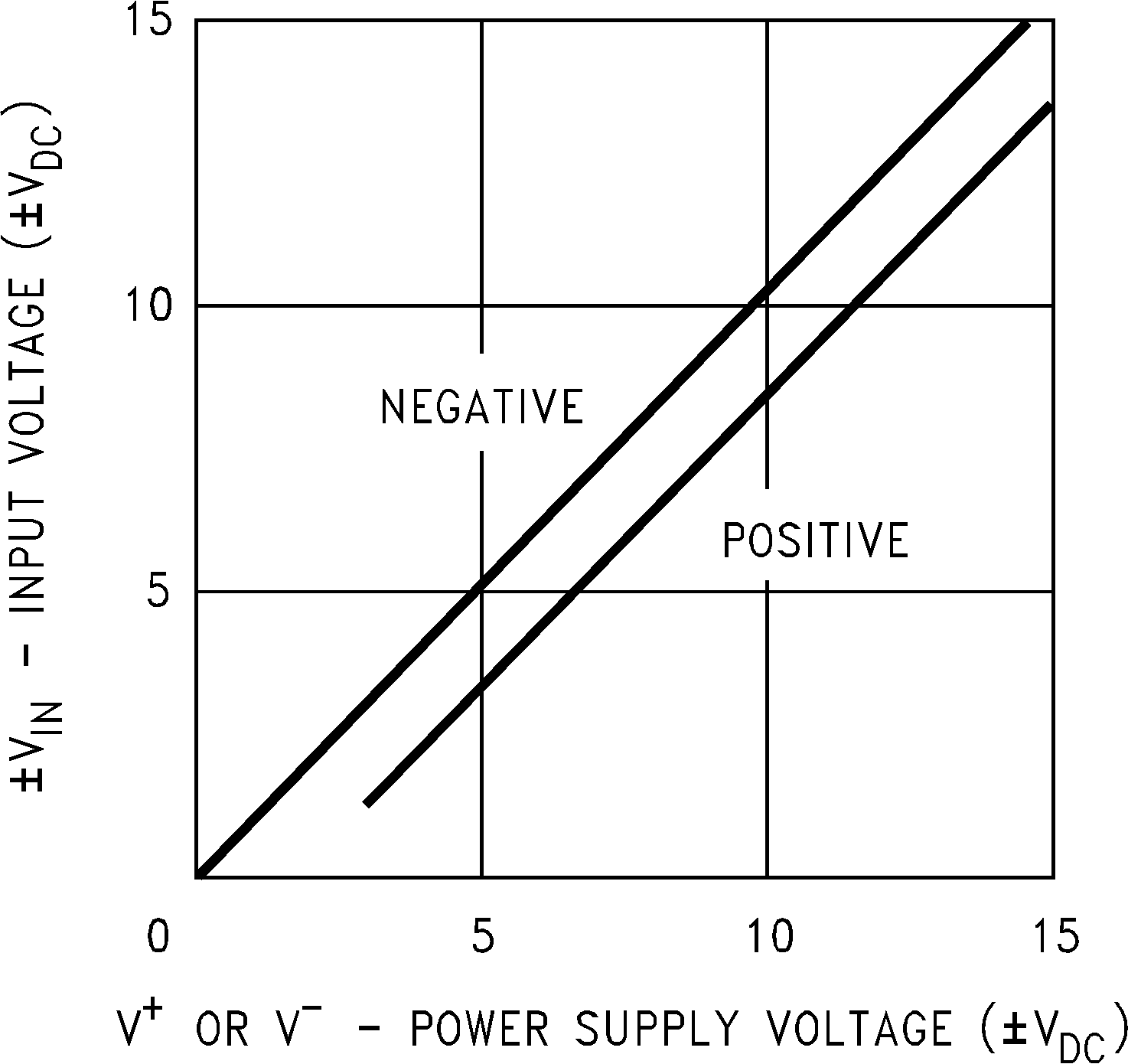 Figure 1. Input Voltage Range
Figure 1. Input Voltage Range
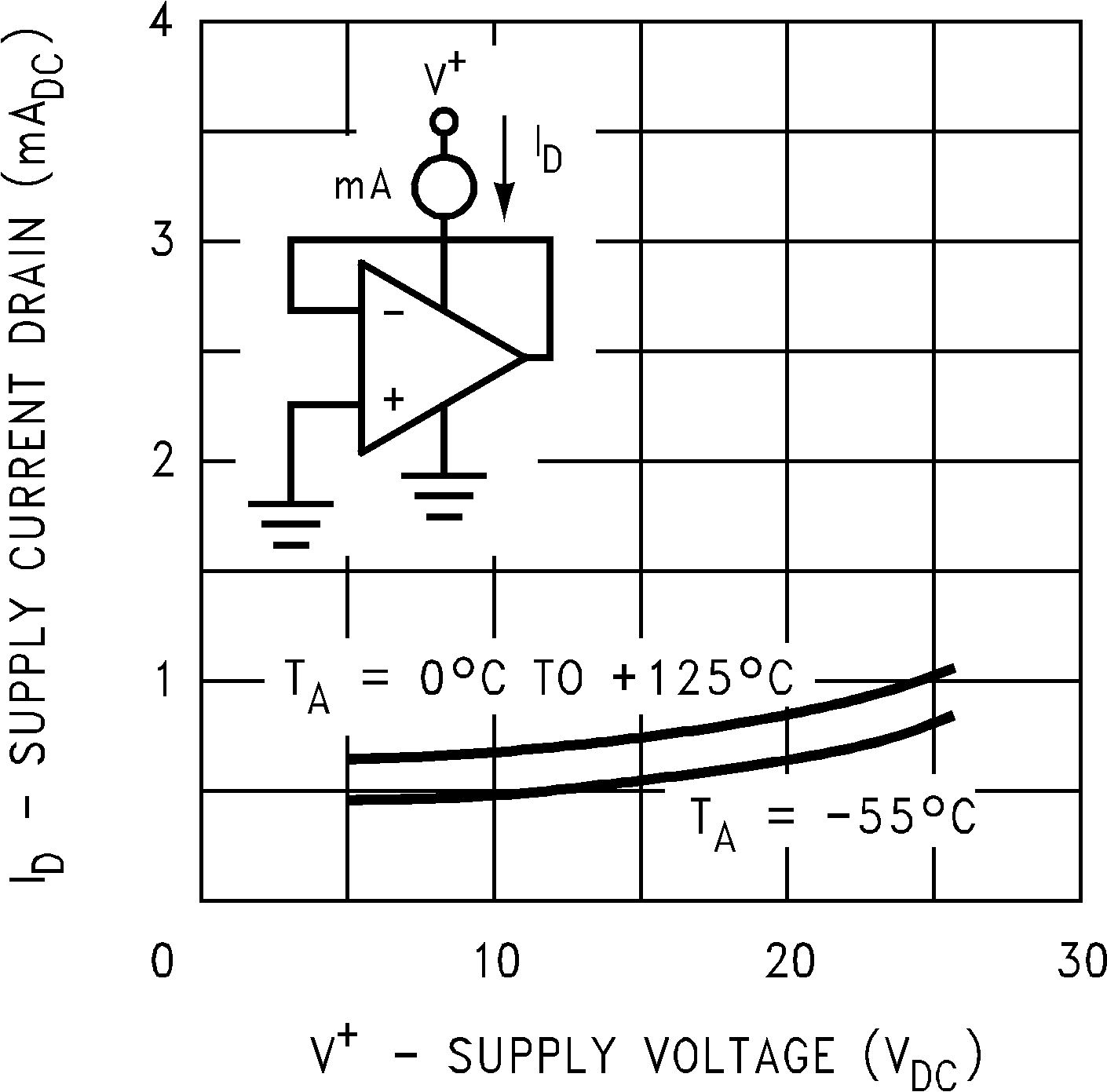 Figure 3. Supply Current
Figure 3. Supply Current
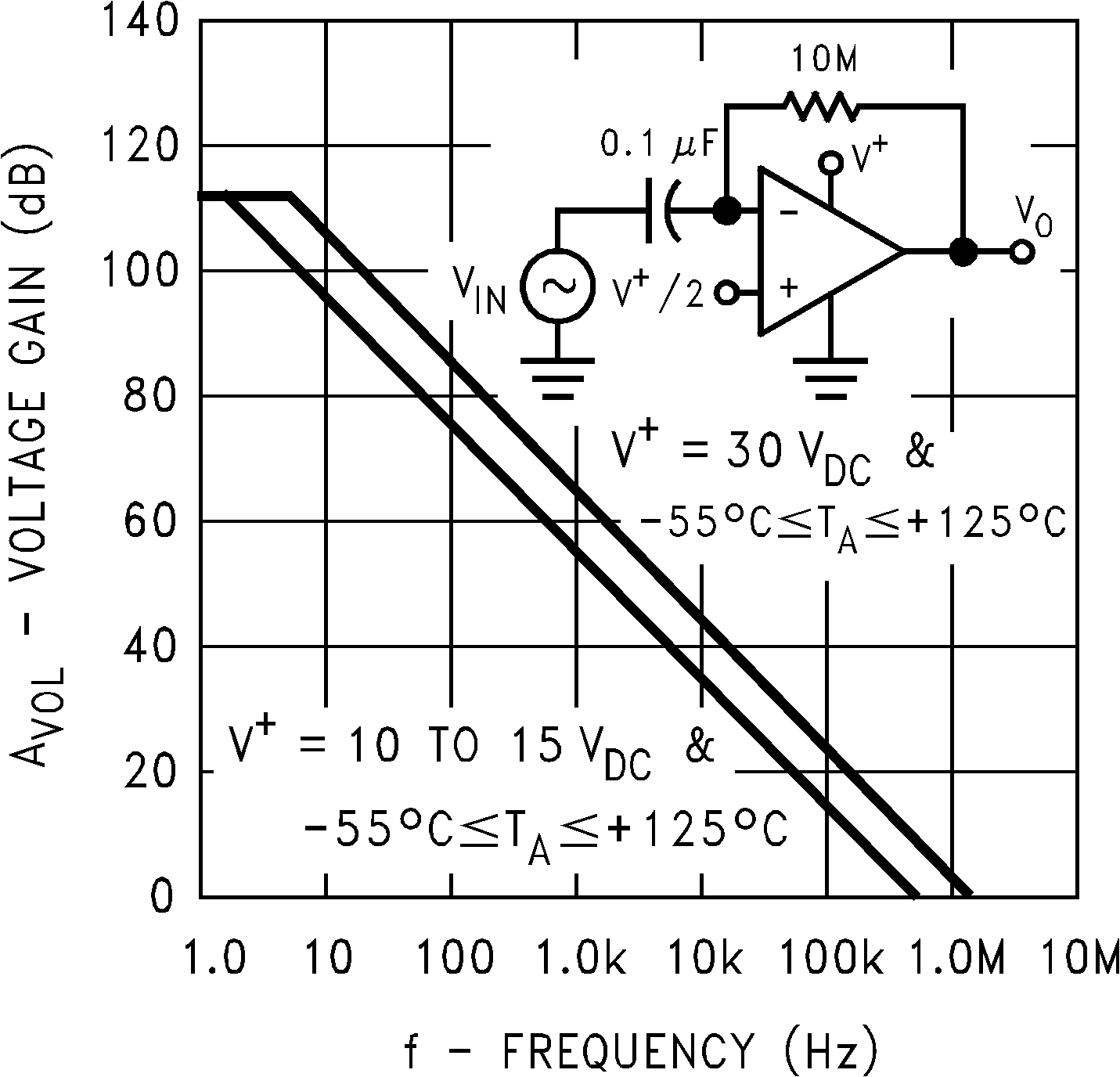 Figure 5. Open-Loop Frequency Response
Figure 5. Open-Loop Frequency Response
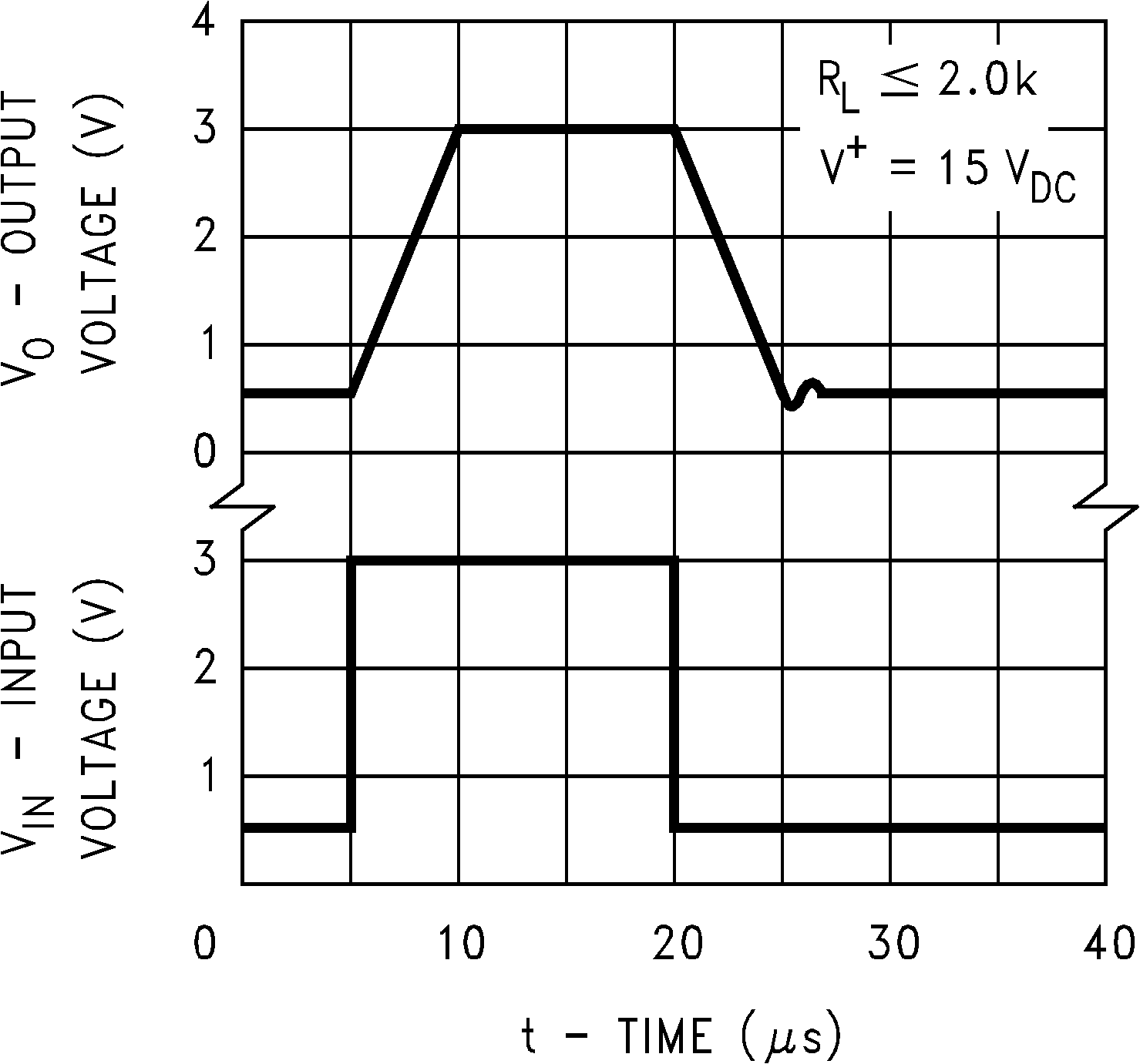 Figure 7. Voltage Follower Pulse Response
Figure 7. Voltage Follower Pulse Response
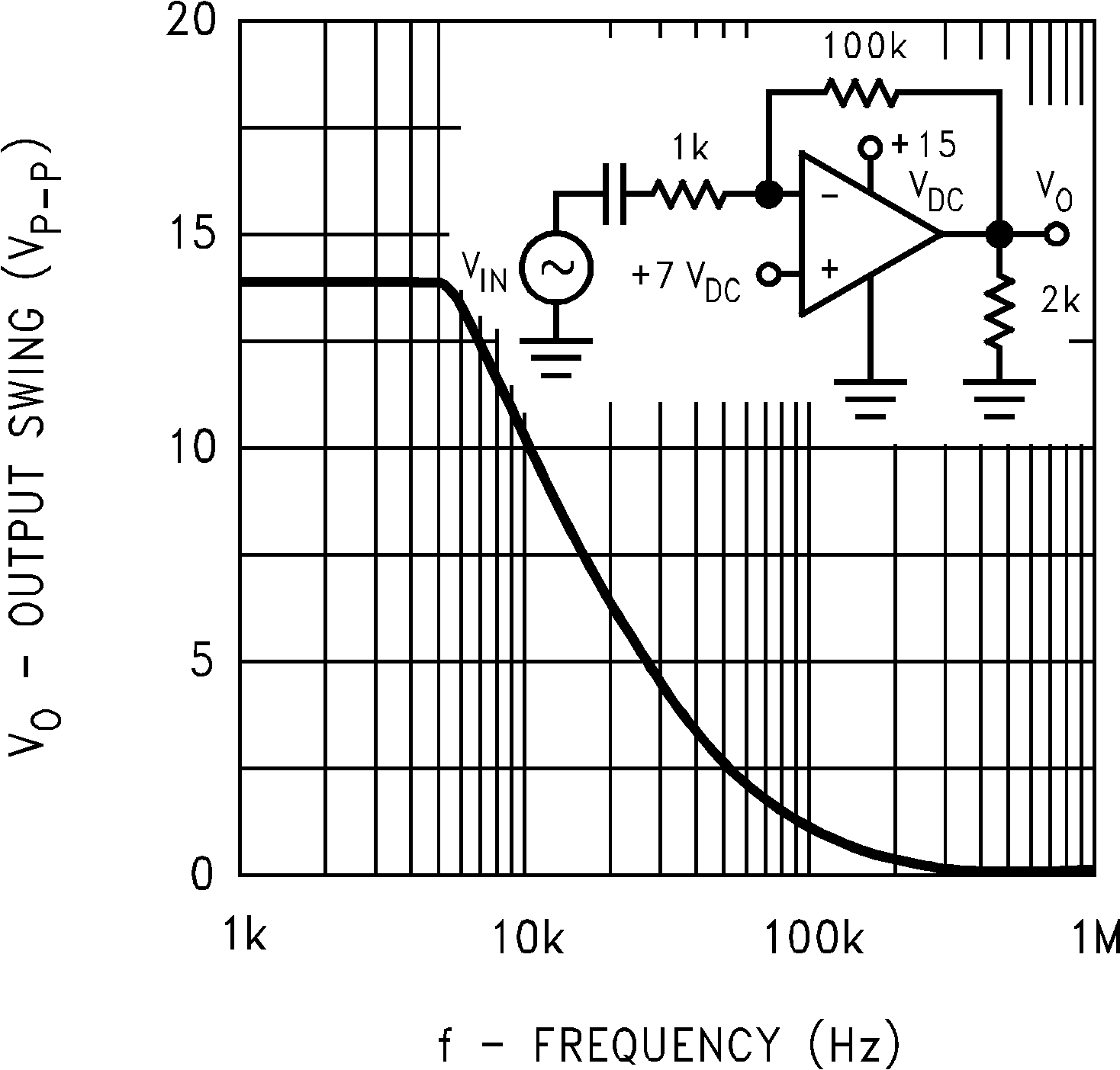 Figure 9. Large Signal Frequency Response
Figure 9. Large Signal Frequency Response
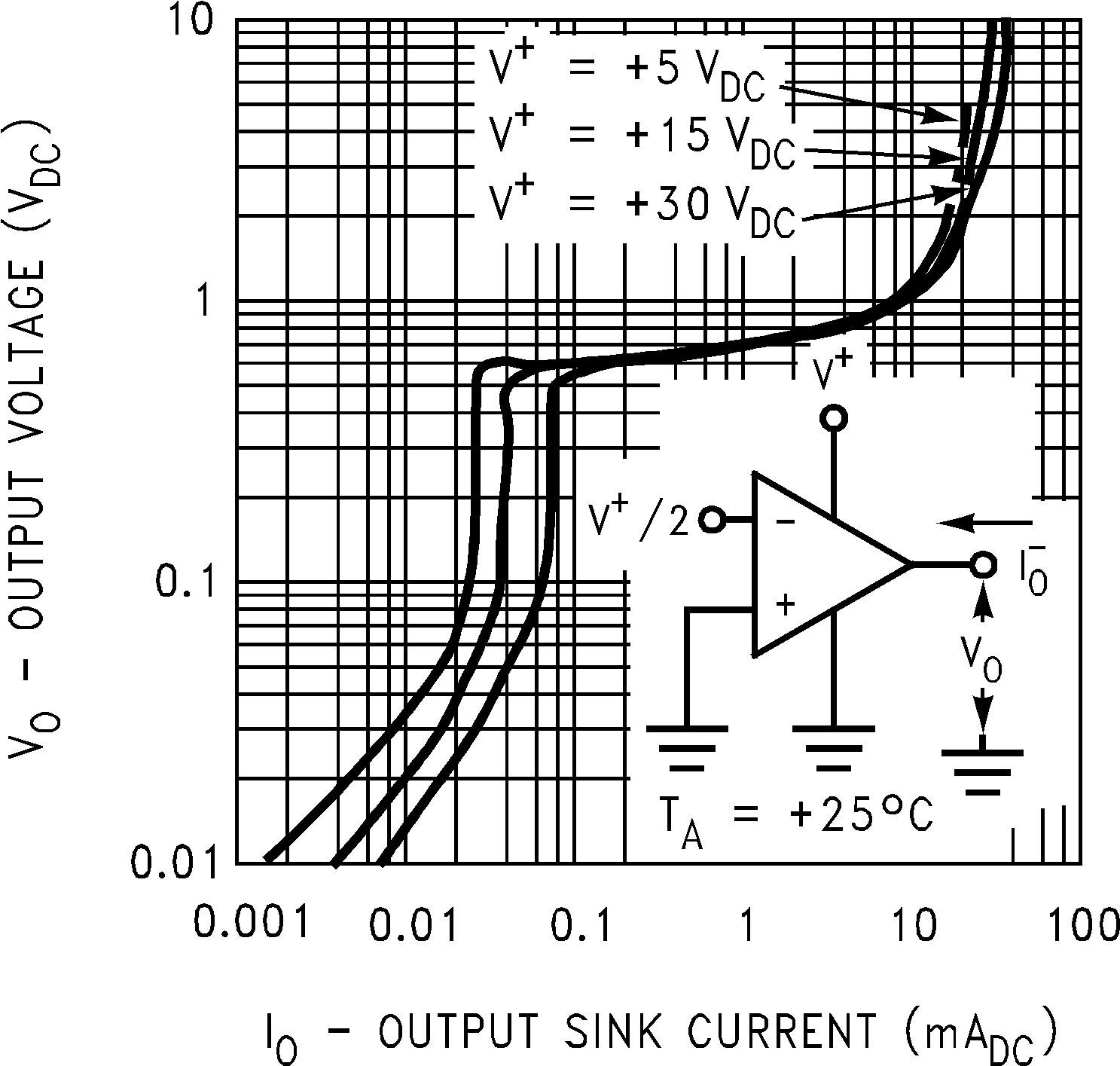 Figure 11. Output Characteristics Current Sinking
Figure 11. Output Characteristics Current Sinking
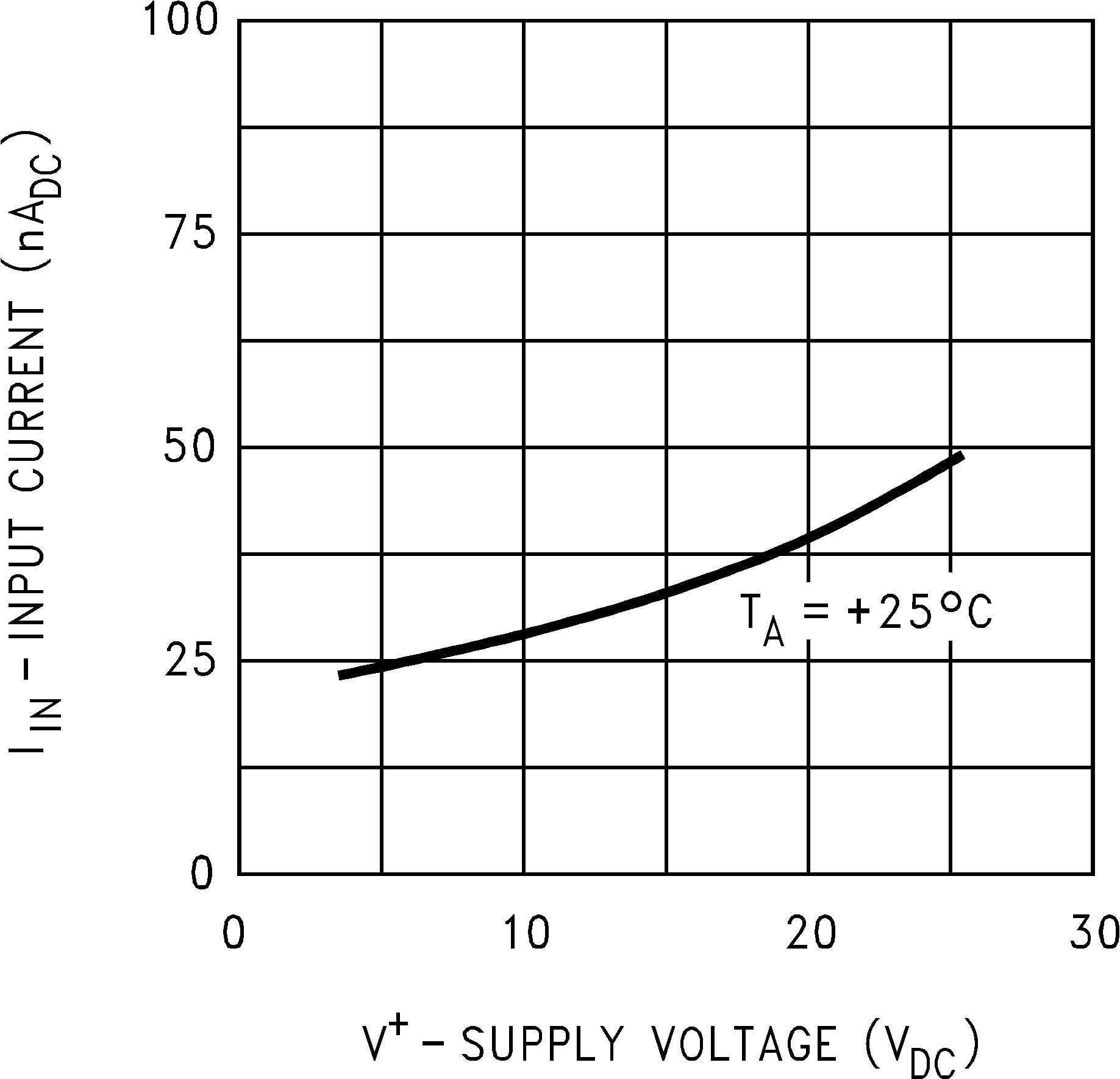 Figure 13. Input Current (LM2902-N Only)
Figure 13. Input Current (LM2902-N Only)
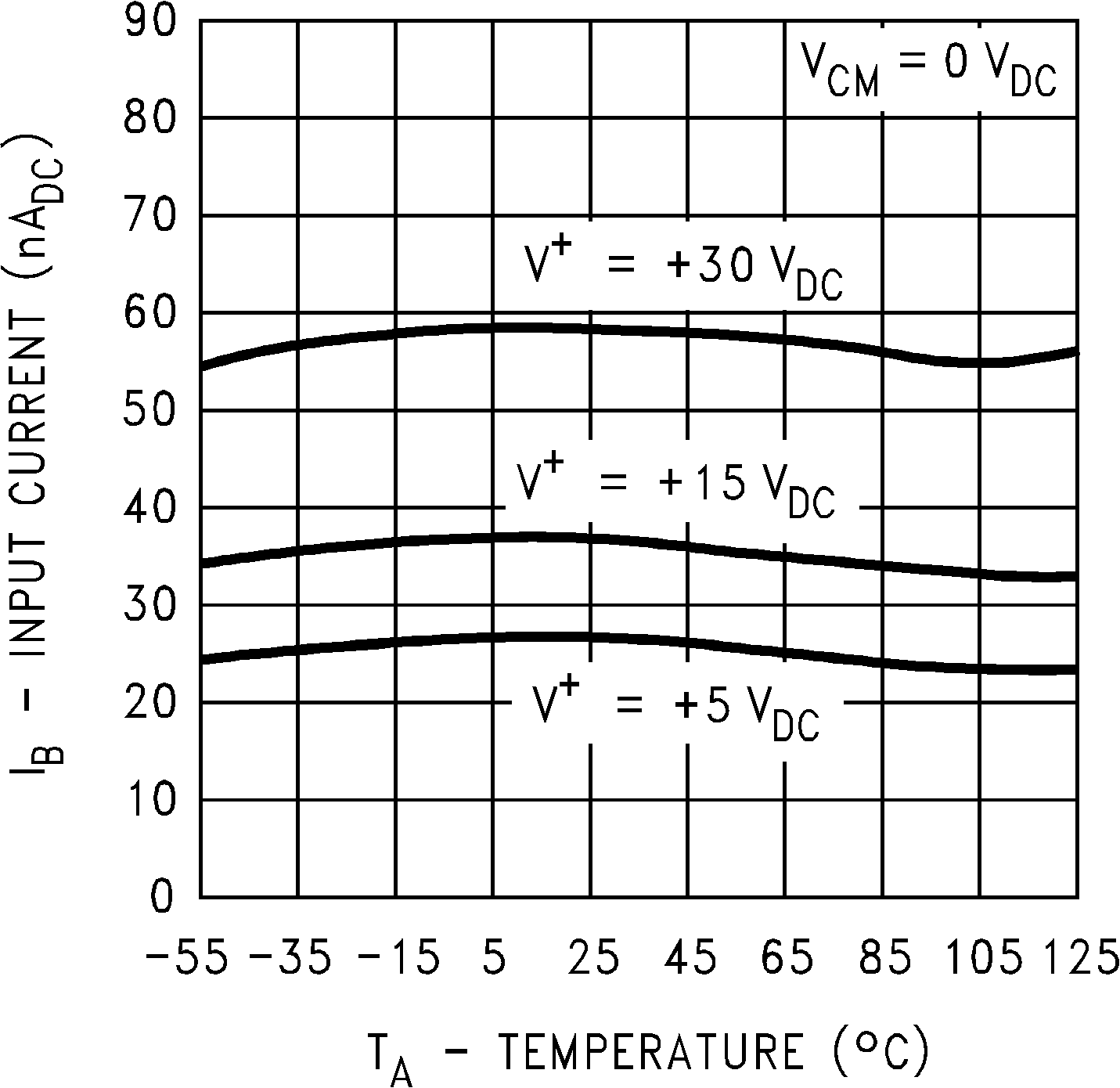 Figure 2. Input Current
Figure 2. Input Current
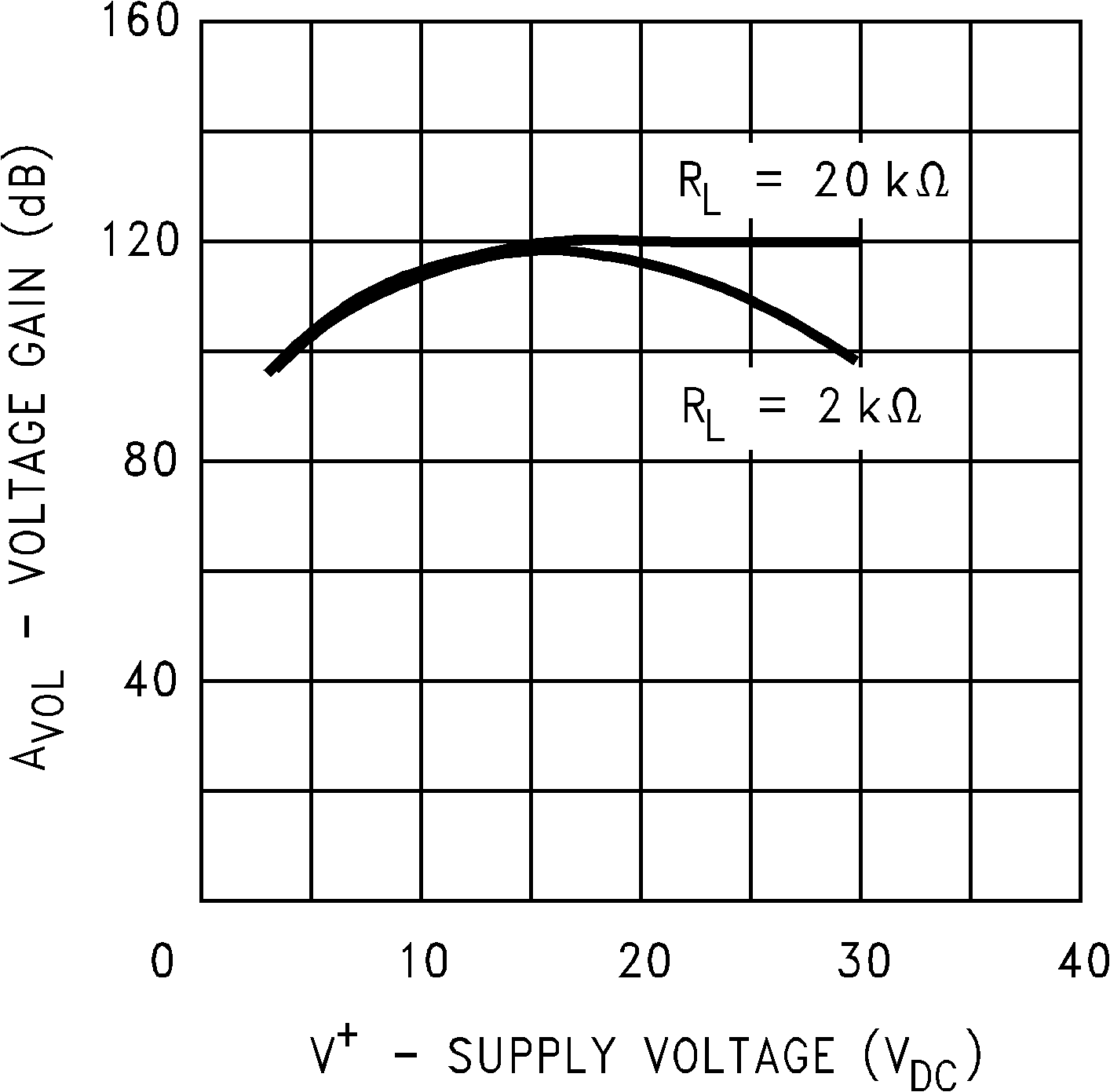 Figure 4. Voltage Gain
Figure 4. Voltage Gain
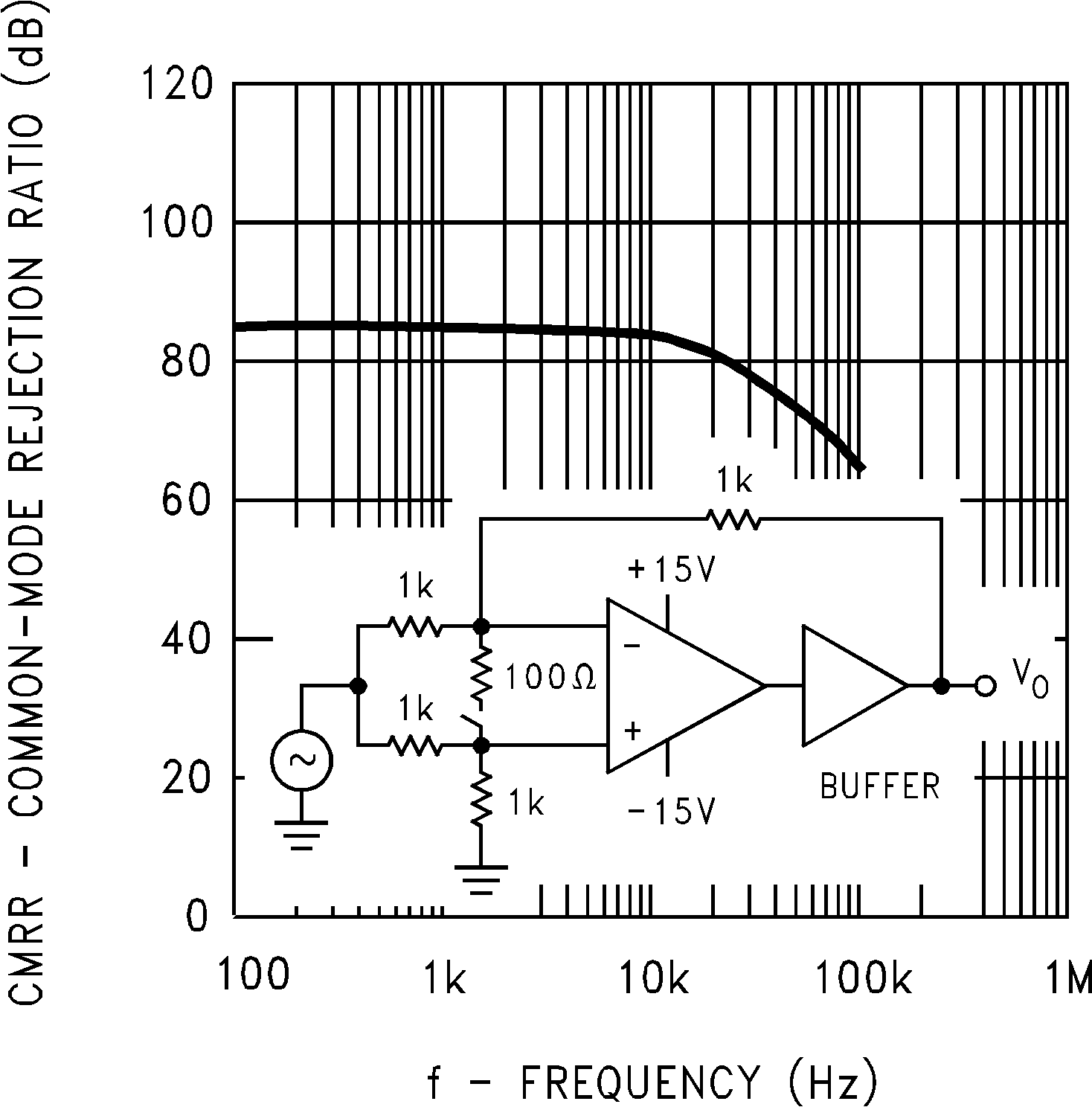 Figure 6. Common Mode Rejection Ratio
Figure 6. Common Mode Rejection Ratio
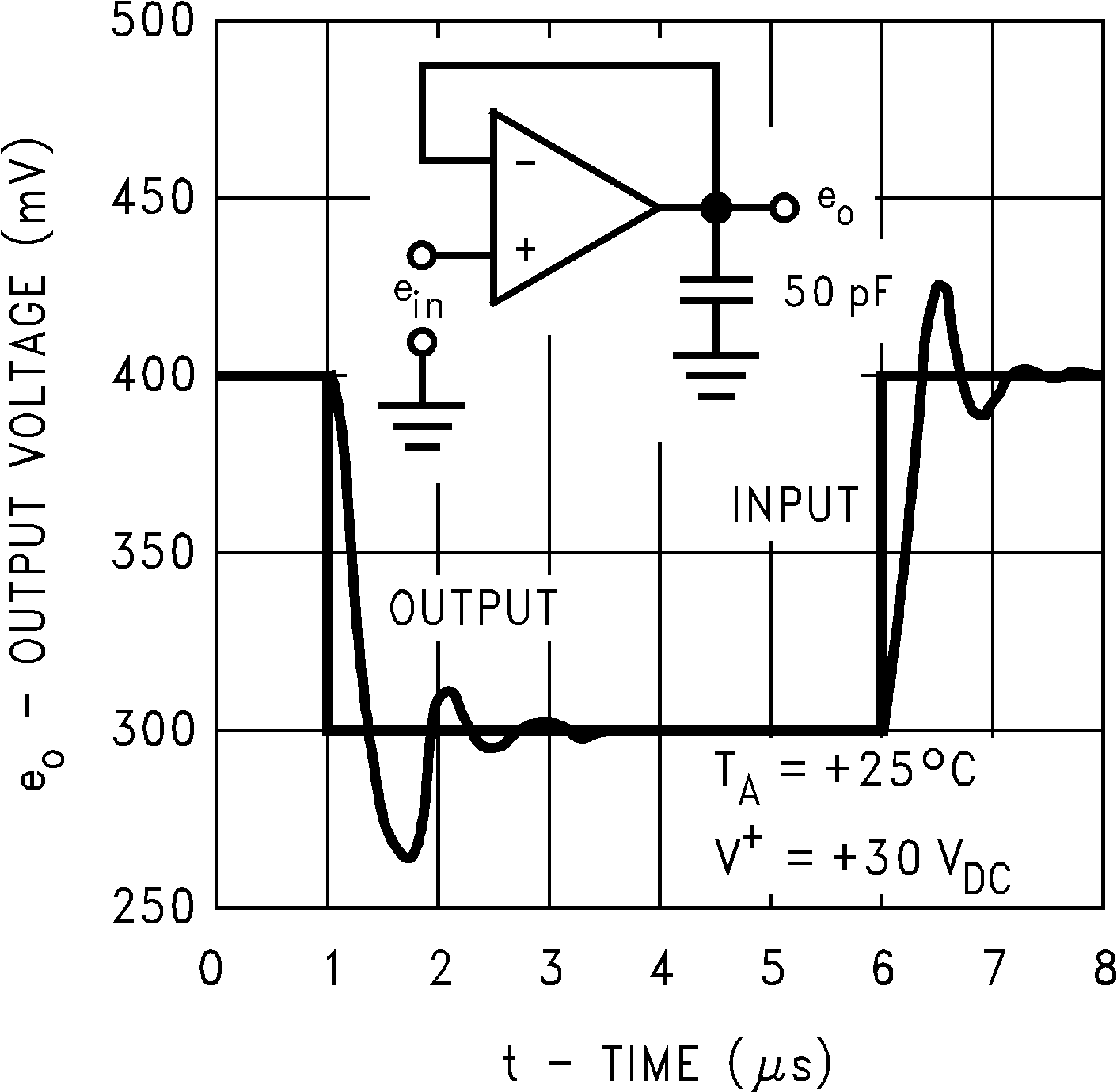 Figure 8. Voltage Follower Pulse Response (Small Signal)
Figure 8. Voltage Follower Pulse Response (Small Signal)
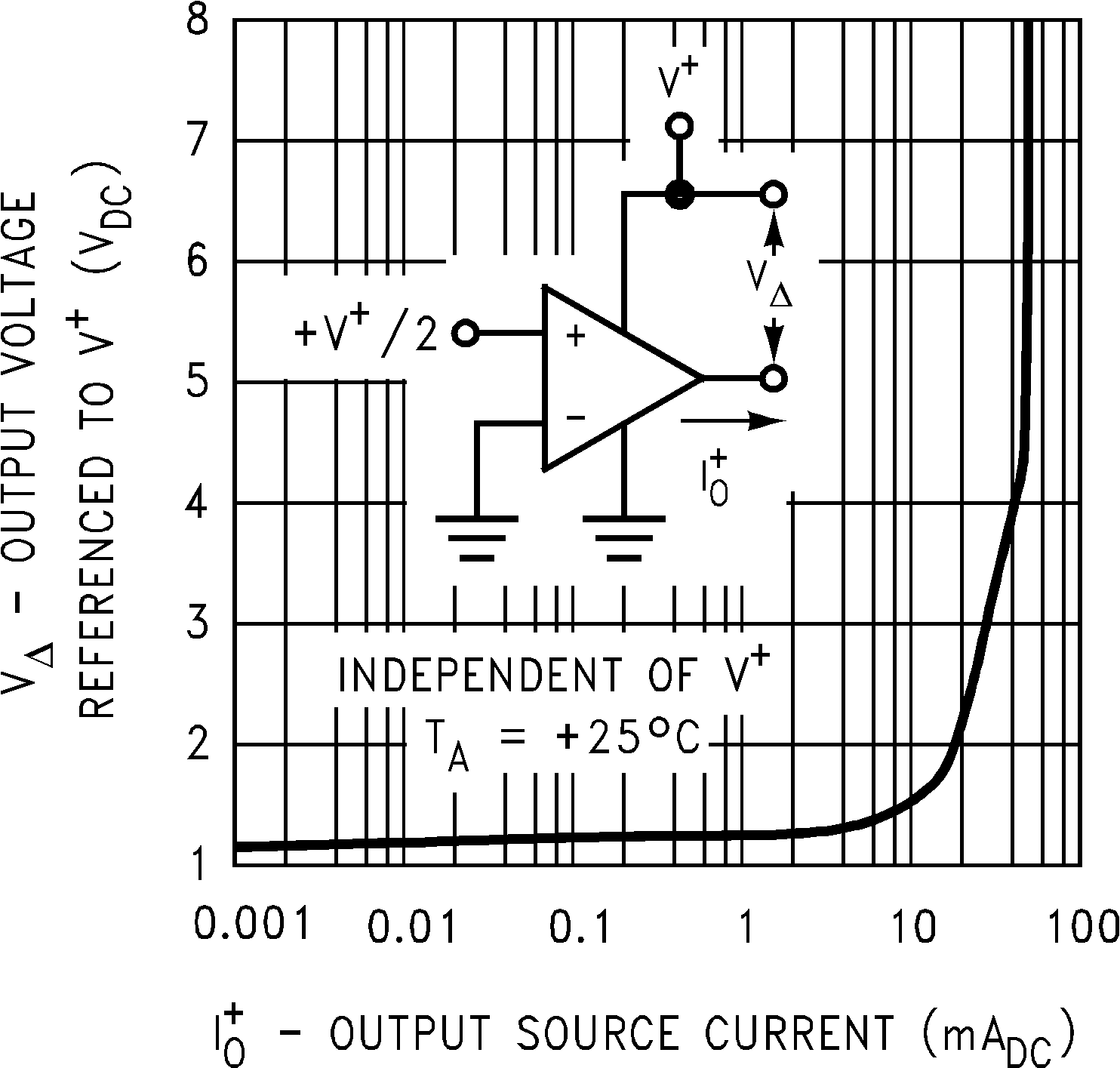 Figure 10. Output Characteristics Current Sourcing
Figure 10. Output Characteristics Current Sourcing
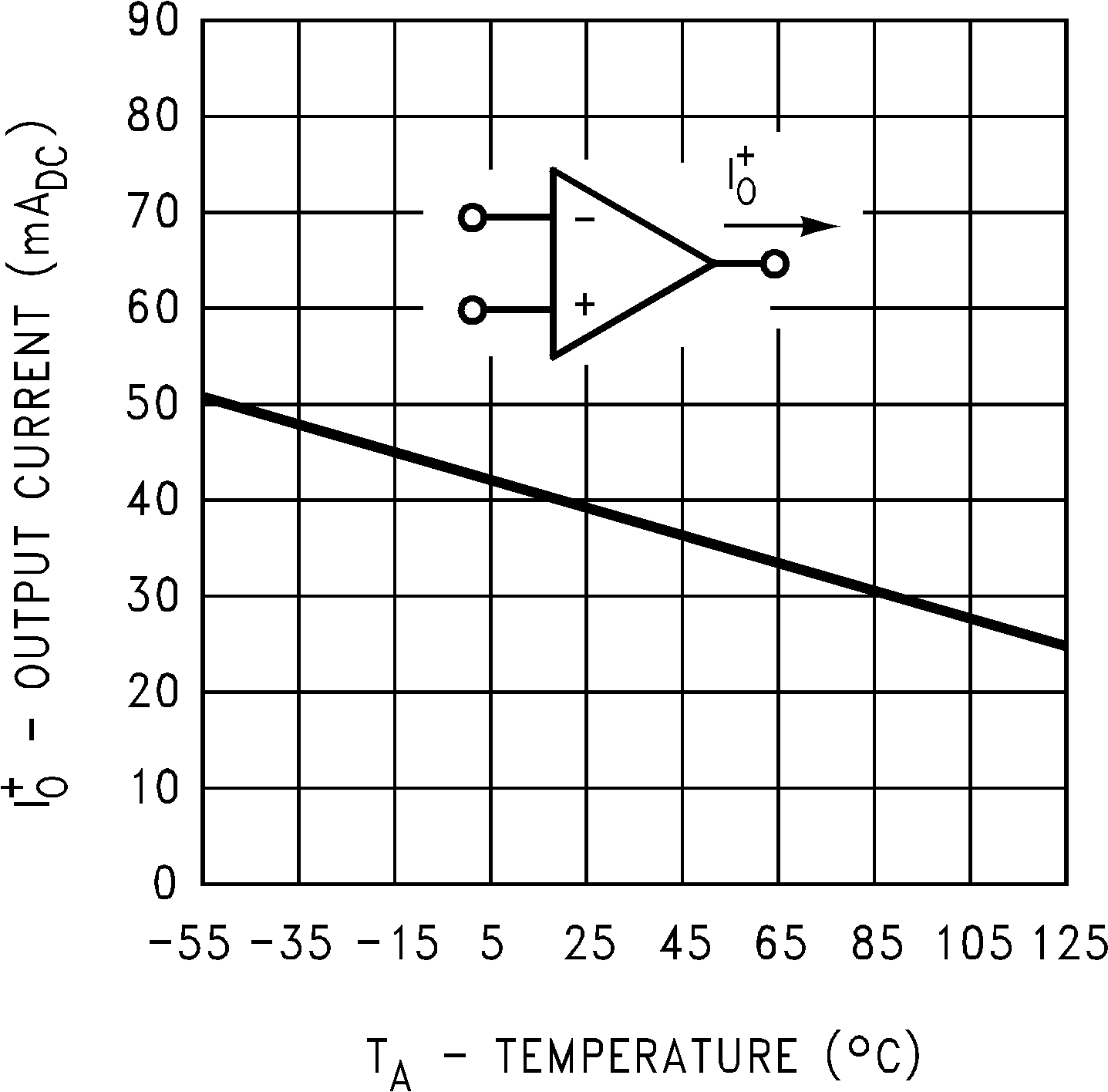 Figure 12. Current Limiting
Figure 12. Current Limiting
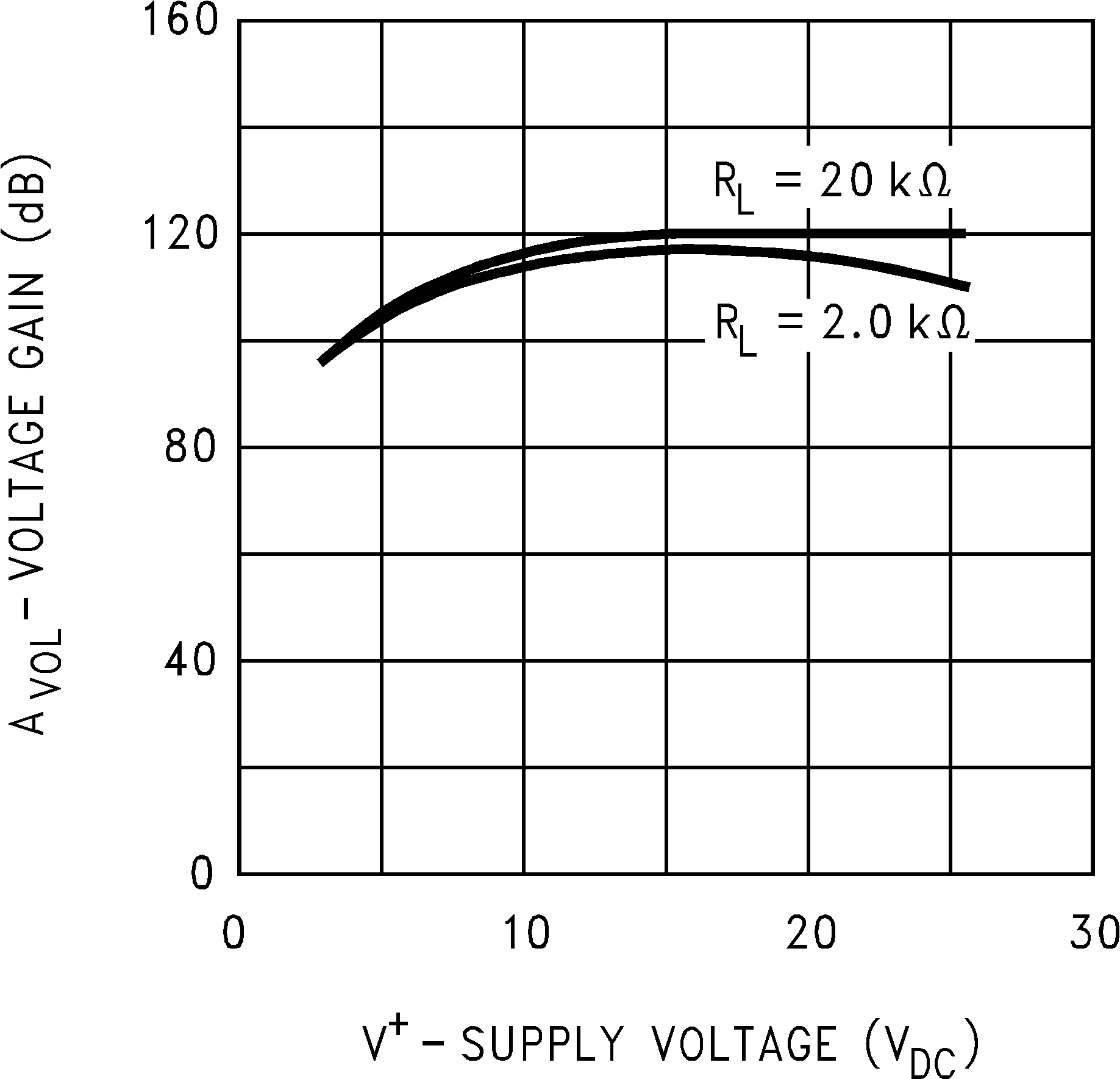 Figure 14. Voltage Gain (LM2902-N Only)
Figure 14. Voltage Gain (LM2902-N Only)